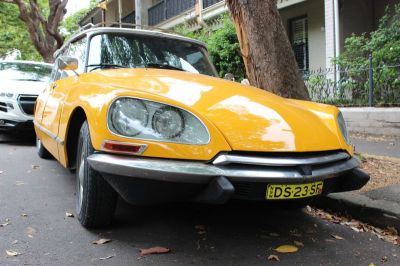 1968 Citroen ID III Break Dimensions, Size & Specs
1968 Citroen ID III Break Dimensions, Size & SpecsMeasurements of the 1968 Citroen ID III Break, engineered for optimal performance and comfort
| Dimensions | |
|---|---|
| Length: | 5040-5050 mm198.4-198.8 in16.5-16.6 ft |
| Width: | 1803-1815 mm71.0-71.5 in5.9-6.0 ft |
| Height: | 1530 mm60.2 in5.0 ft |
| Weight Specifications | |
| Curb Weight: | 1390-1430 kg3064-3153 lbs |
| Maximal permitted Weight: | 2030-2050 kg4475-4519 lbs |
The Citroën ID III Break, produced from 1967 to 1975, is a classic French station wagon known for its practical design and distinctive styling. This generation of the Citroën ID model is characterized by a spacious body that measures approximately 5040 to 5050 mm (198.4 to 198.8 inches) in length, making it a sizable vehicle for its era. With a width ranging between 1803 and 1815 mm (71.0 to 71.5 inches) and a height of 1530 mm (60.2 inches), the ID III Break offers an ample interior space that combined comfort with versatility, suitable for families and long trips.
The curb weight of the vehicle varies from 1390 to 1430 kg (3064 to 3151 lbs), balanced with a maximum weight capacity between 2030 and 2050 kg (4476 to 4519 lbs), indicating its robust build and ability to carry loads typical of a station wagon. The Citroën ID III Break's dimensions reflect its practical nature while preserving the elegant and smooth lines that Citroën is known for in their designs. This generation stands out due to its ease of maneuverability despite its length, with a moderate width that fits well in urban settings.
Overall, the Citroën ID III Break is notable for blending classic 1960s French automotive styling with the functional benefits of a large family vehicle. Its size and weight specifications place it comfortably in the mid-to-large segment for station wagons of its time. This car remains a popular choice among collectors and enthusiasts interested in vintage French automobiles, offering a glimpse into the era's design philosophy focused on utility and comfort.
Discover the standout features that make the 1968 Citroen ID III Break a leader in its class
Have a question? Please check our knowledgebase first.
The Citroën ID III Break, produced from 1967 to 1975, measures between 5040 mm to 5050 mm in length, equivalent to approximately 198.4 to 198.8 inches. This length places it among the longer station wagons of its time, providing ample interior space and cargo capacity relative to its era.
The width of the Citroën ID III Break ranges from 1803 mm to 1815 mm, or roughly 71 to 71.5 inches. This moderate width balance offers a stable road presence, enhancing handling while maintaining comfortable seating for passengers inside. The width also contributes to a roomy interior, typical of a station wagon designed for family and cargo utility.
Standing at 1530 mm (approximately 60.2 inches) tall, the Citroën ID III Break has a height that suits its station wagon design by providing sufficient headroom for passengers. This moderate height contributes to good aerodynamics and stability while also enabling easier garage parking compared to taller SUVs.
The Citroën ID III Break weighs between 1390 kg and 1430 kg (approximately 3060 to 3150 lbs) when empty, and its maximum weight capacity ranges from 2030 kg to 2050 kg (roughly 4475 to 4515 lbs). This weight range reflects its robust build and ability to carry significant passenger and cargo loads typical for a mid-20th-century station wagon.
Yes, the Citroën ID III Break generally fits into a standard garage, but with some considerations. Typical garage dimensions are, on average, about 2.4 meters (7.9 feet) wide and 5 meters (16.4 feet) long. The ID III Break's length is right around 5.04 to 5.05 meters (about 16.55 feet), which is slightly longer than the typical garage length, so fitting it comfortably may require a garage with extended length or careful parking. The width and height comfortably fit within standard garage width and height dimensions, making it manageable for most home garages designed for sedans and station wagons.
Compared to its predecessor, the Citroën ID II and related DS Break models, the ID III Break is noticeably longer and slightly wider. Its length of about 5040 to 5050 mm (198.4 to 198.8 inches) surpasses earlier models, which typically measured closer to 4800-4900 mm. This increase in size was aimed at providing more interior room and cargo space. Width increased slightly as well, enhancing stability and passenger comfort. The overall design evolution reflects Citroën's focus on spaciousness and versatility in the ID III Break compared to the earlier generation's more compact dimensions.
In the late 1960s, the Citroën ID III Break was competitive in size within the European station wagon market. Its length of over 5 meters (about 198 inches) made it one of the larger wagons, comparable to vehicles like the Mercedes-Benz W114/W115 estate or the Peugeot 504 wagon. Its width of approximately 1.8 meters (71 inches) provided a spacious cabin without being unwieldy on narrower European roads. While some contemporaries offered slightly more cargo volume or length, the Citroën balanced size with innovative suspension technology and distinctive styling, making it a unique choice in its class.
The Citroën ID III Break was designed as a practical and spacious station wagon. With its extended length and wagon body style, it offers considerable cargo space behind the rear seats, suitable for families or carrying bulky items. The vehicle's overall width and height translate to generous passenger room with good headroom and comfortable seating positions. The flexible rear seating typically folds down to expand cargo volume further, enhancing its utility. While exact interior volume numbers are not always published from that era, the dimensions suggest a very functional interior comparable to other mid-to-large station wagons of the period.
The Citroën ID III Break, produced between 1967 and 1975, represents an important chapter in Citroën’s legacy of innovative and practical vehicle design. Part of the ID line that was a more affordable alternative to the DS models, the ID III Break combined the hallmark Citroën features such as hydropneumatic suspension for superior ride comfort with the practicality of a station wagon body. It was well-regarded for its spaciousness, smooth ride, and distinctive styling. The production span until 1975 saw it compete well in a market transitioning from traditional wagons to more modern designs.
Owning a Citroën ID III Break today as a classic car involves understanding the specific maintenance needs arising from its original design and technology. The large size, hydropneumatic suspension system, and mechanical complexity demand careful upkeep. Due to its curb weight of up to around 1430 kg (3150 lbs) and large dimensions, handling and parking considerations remain important, especially in tight urban spaces. Fuel economy and emissions will naturally be lower and higher, respectively, than modern cars, reflecting engineering norms of the late 1960s and early 1970s. Yet, enthusiasts appreciate its unique ride comfort and spaciousness despite these challenges.
Discover similar sized cars.

| Production: | 1972-1975 |
|---|---|
| Model Year: | 1972 |
| Length: | 5026 mm197.9 in |
| Width: | 1803 mm71.0 in |
| Height: | 1530 mm60.2 in |
